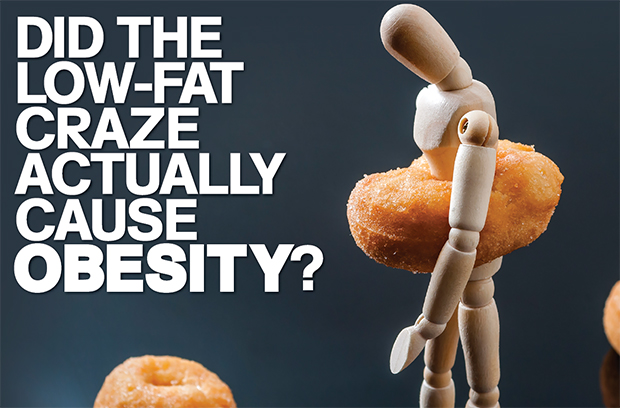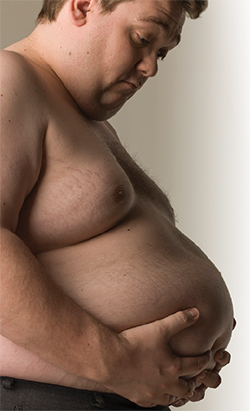Do Low-Fat Diets Cause Obesity?

There’s always some new superstar diet, food or nutrient that the media or the food industry decides is the new key to health or to getting the perfect body. Similarly, there are always others being blamed for being the secret new cause of obesity or disease. This has been happening for decades. The last 15 to 20 years have seen a “diet” or “superfood” or “health scare” story in the media virtually daily. Of course, at the most basic level, our diet primarily consists of the macronutrients protein, carbs, and fat (and alcohol). Unsurprisingly, it’s these three macronutrients that have been subject to the most controversy over the years, and this situation shows no signs of stopping!
The biggest disagreement is still about fat intake, but many have turned the corner and now focus on the consumption of excess sugar, and a few have blamed processed starches as the key cause of obesity. Many see this whole debate as cut and dry, but it’s far from that. As with all nutritional debates, arguments on each side could be considered legitimate. Most important in this debate are three concepts. First off, some people do better when they restrict mostly carbs and some do better when they reduce mostly fat. Second, what’s the definition of “low fat” or “low carb”—is 40 percent carbs low or do you only consider it low carb when it gets down to 5 to 10 percent? And third, what type of carbs or fat is being reduced or added into the diet?
But was there ever any evidence to support the low-fat craze, and have all of the fat-phobic messages from government health agencies actually been the biggest cause of the obesity epidemic?
 Background on the Anti-Fat Movement
Background on the Anti-Fat Movement
The anti-fat movement began in the first part of the 20th century, when women felt pressured to fit into the tighter, fashionable clothing of the 1920s. Then, during WWII, insurance companies came up with weight charts that reinforced the new slimmer trend, and subsequent charts that they released recommended even lower ideal body weights. Soon, by the 1950s, doctors were on board with the low-fat message, promoting it as the best way to avoid the biggest killer, heart disease. Despite all of this, the typical middle-class American diet was still high in fat, comprising meat, fried foods, sausages, whole milk, burgers, butter, gravy, and other high-fat favourites. Between the 1950s and 1970s, various evidence published in medical journals and released by the American Heart Association suggested that saturated fats were associated with heart disease and that reducing them in the diet “may” reduce the risk. It should be noted that they were very careful not to be definitive that this approach would work at the time!
Then, in 1977, a document called “Dietary Goals in the United States” was published by the U.S. Senate’s Select Committee on Nutrition and Human Needs. It recommended lowering fat in the diet (along with sugar and salt, which seemed to get less press than fat) and also implicated dietary fat in obesity. So without any new definitive evidence, now the cautious suggestions that fat may cause heart disease had turned into government policy, and they threw in obesity as an outcome of scarfing down too much lard also … for which (again) there was no good evidence.
The final nail in the coffin was in 1983, with the release of a study based upon data from the massive Framingham studies, which followed the diets and health of thousands of Americans. This study implicated obesity as a major risk factor for heart disease. Although it’s clear that obesity increases heart disease risk, the conclusion that eating less fat would prevent either obesity or heart disease wasn’t yet proven but was being portrayed to the public as if it had been! In fact, it wasn’t until 2002 that a huge Harvard review of 147 studies on the relation between dietary fat and heart disease made it clear that there was never any good evidence to support the anti-fat movement in the first place. Around the same time, other massive reviews of the science were also concluding that there had never been any good evidence that fat in the diet makes people fat! Here’s what Dr. Walter Willett—the world’s most published nutrition scientist and Chair of the Department of Nutrition at the Harvard School of Public Health—has to say on the topic: “Diets high in fat do not account for the high prevalence of excess body fat in Western countries” and “The emphasis on total fat reduction [in the diet] has been a serious distraction in efforts to control obesity and improve health in general.”
So there we have it. Massive review studies from the world’s number one academic institution and the most prolific nutrition expert in the world concluded that the entire low-fat message was a lie. Millions of dollars spent by governments all over the world espousing cutting fat from the diet probably haven’t improved health or the epidemic of obesity. And the low-fat message is still getting shoved down our throats by government health agencies and others. Even more concerning is that it seems as if most dietitians still haven’t got the message. These are the nutrition professionals who have university degrees in nutrition and work in hospitals and who help form policy regarding what we should eat to avoid obesity and disease, and chances are, the next time you see one of them on the news, they’ll make some comment that suggests we should avoid fat!
Does Low Fat Cause Obesity?
It’s bad enough that we were all led down the low-fat path despite a lack of evidence of its benefits, but there’s the other equally important question of whether higher carb eating caused by the anti-fat movement has actually increased obesity, and there’s certainly a case to be answered here!

Fast Facts
• From 1965 to 1997, there was a 20 percent increase in carb intake in the USA but with very little change in fibre intake.
• When carb intake goes up that dramatically with no change in fibre intake, that means all of those extra carbs people now eat are refined, high-GI starches and sugars. Over the 30 years in which the obesity epidemic was taking hold, people were gradually eating more sugar and processed starches.
• In 1977, the average American ate 400 grams of carbs per day, and the obesity rate was 15 percent.
• In 1990, carb intake had gone up to 460 grams, and obesity had hit 23 percent.
• In 1997, carb intake had gone up to 500 grams per day, and obesity had hit 27 percent. So between 1977 and 1997, carb intake went up 20 percent and obesity rates almost doubled.
 Carb Intake & Obesity
Carb Intake & Obesity
A study looked at 30 years’ worth of data in the US, along with 10 years of data from 164 other countries, concluded that a one percent increase in carb intake increases the rate of obesity by one percent. Even more damning for low-fat advocates is their conclusion that increasing fat intake actually causes a small decrease in the incidence of obesity! So it looks like there’s a very compelling case that increased carb intake does cause increased obesity. However, there are two caveats here: First, these greater carb intakes have usually occurred at the same time as increased calorie intake. And second, the increased carb intake experienced in most parts of the world in the last several decades has been as sugar and refined starches, so it may be a bit misleading to just talk about “carbs” since not all carbs are the same.
Carbs & Hunger
It could be that increased carb intake actually drives greater calorie intake by increasing appetite. As MUSCLE INSIDER readers will know, carbs are the biggest stimulators of insulin. Several studies have shown that insulin may actually decrease hunger, however there are even more studies that have shown that insulin can actually increase hunger! Any competitive bodybuilder who’s used insulin can attest to its appetite-increasing effects. However, the small number of studies means we can’t oversimplify this relationship.
Carb Sensitivity
Are some people more likely to get fat on a high-carb diet? The simple answer is “yes.” Clear evidence shows that despite whether they have a healthy lifestyle or not, some people are much more likely to metabolize carbs poorly than others, and research suggests that those who have good insulin function can lose weight simply by cutting calories, while others (those with poorer insulin sensitivity) need to focus mainly on cutting carbs to achieve diet success. So any suggestion that carbs cause obesity must be tempered by the realization that higher carb intakes will have different effects on different people.
What’s a “Low-Fat” Diet?
When comparing diets, we often see headlines like “low-carb diet causes more weight loss than low-fat,” but definitions of these respective diets can vary dramatically. Generally, a low-fat diet is one that contains less than 30 percent of its calories from fat, but some studies use 20 percent or even less. Carbs can vary even more dramatically; I’ve seen diets with 40 percent carbs called “low carb,” while other studies go as low as 5 percent. There are now hundreds of diet studies using fat and carb intakes in these broad ranges, and it takes a huge amount of reading and scrutinizing to try to figure out where the “sweet spot” is (I know because I’ve done it!), and then you have to further tailor macro intakes to fit the carb sensitivity of the dieter. Going back to the main point of this article, looking at how carb and fat intakes changed as the obesity crisis took hold, it actually looks as if going from close to 40 percent calories from fat in the diet towards 30 percent fat is the range of change that seems to have caused the problem. Therefore, it’s not surprising that 30 percent fat diets and those below 30 percent aren’t as effective for weight loss as higher fat diets.
Conclusion
Was the low-fat craze that had its roots in the early 1920s, gathered steam in the late 1970s, and became government policy in the 1980s responsible for the obesity epidemic? Well, it’s difficult to prove cause and effect in these kinds of cases, but it looks that way. The fact that people seem to have simply swapped some fat in their diets for sugars and processed carbs meant that this change was doomed from the start. However, if health journalists and medical professionals had been doing their jobs properly and asking the right questions to the right experts and properly following good research, this could have been avoided. If food companies hadn’t jumped on the bandwagon and helped get the Western world addicted to cheap, processed, nutrient-poor starches and sugars, it also could have been avoided. Of course, it’s a bit simplistic to say that “carbs” cause obesity because no one ever got fat by increasing their fibre (which is a carb) intake. In fact, higher fibre intake is associated with significantly lower body fat. Similarly, when it comes to dietary fat, some athletes are genetically predisposed to gain more body fat eating higher fat intakes than others. All carbs and fats aren’t created equal and shouldn’t be presented as such. Finally, one thing we do know for sure is that swapping out fat or carbs for protein in the diet is a winning strategy. Aim for eating a minimum of 1 gram of protein per pound of body weight for maximum results.

HOW YOU SHOULD BE EATING
If you want to look like a bodybuilder, you have to eat like a bodybuilder. If you eat junk, you will look like junk. It’s that simple. The late Robert Kennedy, respected MuscleMag International founder, always maintained that bodybuilding is 80 percent nutrition. As the saying goes, you are what you eat. To look and feel your best, follow the dietary example of top athletes and bodybuilders. High protein, green vegetables, high-fibre carbs, good fats and quality calories. Train hard. Eat smart.
THE MUSCLE INSIDER SAMPLE BODYBUILDER DIET (ONE DAY):
Meal 1
• 1/2 cup oatmeal made with water
• 6 egg whites cooked with 1 yolk
• 1 piece fruit
Meal 2
• 1 cup green veggies
• 8 oz. chicken breast
Meal 3
• 1 cup green veggies
• 6 oz. lean steak
• Large baked potato with skin
(3"–4" in diameter)
Meal 4
• Low-carb, low-sugar protein bar
Meal 5
• Omelet made with 8 egg whites and 1 yolk, cooked with 1/2 cup broccoli, 2 mushrooms, fresh salsa

